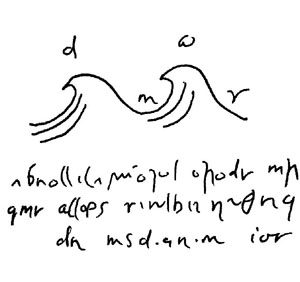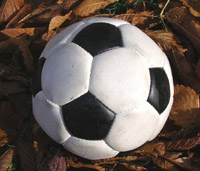Drawing the football
"We have all seen footballs 100's of times - they should be easy to draw. But when we try we tend to get into trouble. We vaguely know that there are patches of different shapes and colours on the round ball. But then when we come to draw it we realise that we don't actually know the structure very well at all. Just like the various rules artists use for drawing we can uncover the structure behind the football and so help us draw it more accurately. "
Dr. Jonathan Hare
The Creative Science Centre University of Sussex
We Think We Know a Football - Drawing
In this article we explore the shape, symmetry and surface structure of a football to see how this understanding can help us draw these sorts of complex shapes. We all know that drawing is not always as easy at it looks. Sometimes, however a few tricks can really help us draw more effectively. For example, knowing that the eyes are roughly halfway down the head can really help drawing a realistic face. Rules like these can transform our ability to draw. What follows is an exploration of the structure (the detailed shape) of the 'common or garden' football, known as a soccer ball in the USA. We do this so that we can find simple rules that will enable us to draw this familiar object more realistically. What we learn could be applied to drawing all sorts of other symmetrical objects and shapes.
Seeing Things Clearly - Observation
To accurately observe what is in front of us is surprisingly difficult. We are so used to seeing things that we often get lazy and rather than 'looking and seeing' we tend to anticipate (from past experience) what we think is really there.
Both the scientist and the artist need to clearly observe in order to progress - in that sense they have a lot in common. This process can be seen so well in the work of Leonardo da Vinci.
In Michael White's wonderful book "Leonardo the first Scientist" he quotes Leonardo's observations of how waves are set up in water when a pebble is thrown in. What is remarkable about the writing is the clarity of da Vinci's observation. We have all thrown pebbles into water and watched what happened but not all of us have observed what happens so eloquently as Leonardo did almost 500 years ago!
 A copy of a drawing from one of Lenoardo da Vinci's pocket notebooks (Codice Arundel, British Library)
A copy of a drawing from one of Lenoardo da Vinci's pocket notebooks (Codice Arundel, British Library)
"If you throw two small stones at the same time on a sheet of motionless water at some distance from each other, you will observe that around the two percussions numerous separate circles are formed; these will meet as they increase in size and then penetrate and intersect one another, all the while maintaining as their respective centres the spot struck by the stones. And the reason for this is that the water, although apparently moving, does not leave its original position, because the opening made by the stones closes again immediately. Therefore the motion produced by the quick opening and closing of the water has caused only a shock, which may be described as a tremor rather than movement. In order to understand better what I mean, watch the blades of grass that because of their lightness float on the water, and observe how they do not depart from their original positions in spite of the waves underneath them caused by the occurrence of the circles. The reaction of the water being in nature of tremor rather than movement, the circles cannot break one another on meeting, and as the water is of the same quality all the way through, its parts transmit the tremor to one another without change of position. Thus the water, although remaining in its position, can easily transmit the tremor to the adjacent parts, these transmitting it to other adjacent parts, while its force gradually diminishes until the end."
Leonardo da Vinci, Manuscript A, Institute de France, Paris
First Drawing
Before we go any further I want you to draw a football. Try to observe what you see in front of you or from your memory of the football shape. Please don’t read on any further until you have tried to draw it.
This content has been re-published with permission from SEED. Copyright © 2025 Schlumberger Excellence in Education Development (SEED), Inc.


